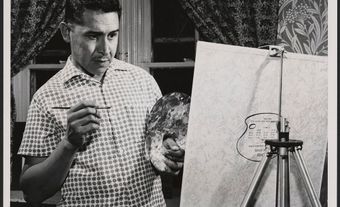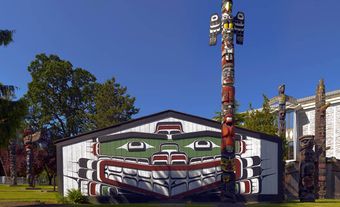
Brian Jungen, artist (born 29 April 1970 in Fort St. John, BC). One of the most highly regarded Canadian artists of his generation; Brian Jungen has received international attention for his elaborate assemblages and installations that draw inspiration from his experience of post-industrial consumerism and his own First Nations heritage.
Beginnings
Brian Jungen spent his childhood in the British Columbia Peace region, where he was born on a family farm north of Fort St. John. His father was Swiss-born and had moved to the region when he was three years old, and his mother was Aboriginal, a member of the Dane-zaa Nation. Jungen's parents died in a fire on the property, after which he was raised by his father's sister and her husband. He continued to maintain ties, however, to his mother's family and heritage.
Jungen moved to Vancouver in 1988, where he attended the Emily Carr University of Art and Design, graduating from there in 1992 with a Diploma of Visual Art. In 1998, he continued his education with a self-directed residency at the Banff Centre for the Arts in Banff, Alberta. It was here that he began a group of artworks that he titled Prototypes for New Understanding that would bring him his first art-world attention and would set the agenda for his later art production.
Innovative Work Draws National Attention
The Prototypes, which occupied his attention between 1998 and 2005, were produced by taking apart and reassembling Nike Air Jordan sneakers to create wry replicas of Northwest Coast Aboriginal masks. With their simple black, red, and white colour arrangements and rubbery forms, the artworks were at first glance startlingly accurate re-creations of the actual artifacts. Closer inspection, however, revealed evidence of their mass-produced origins, complete with Nike “swoosh” and “Made in Indonesia” labels. Michael Jordan’s actual shoes have attained prominent cultural currency and rarity among consumers of sports paraphernalia, with some selling for as much as $31,000 By placing them within an actual museum environment, Jungen invited reflection on cultural value and the conventional representation of Aboriginal culture. Connections were created between traditional Aboriginal culture and popular sportswear fashion, suggesting that by taking the “artifacts” of both out of their real-world context and transforming them into fetish objects, we add value that has no direct connection to their original use.

Subsequent artworks continued Jungen's exploration of the idea of cultural rarity and ceremonial significance contrasted with the ubiquity of the banal products of modern mass production. Three works, Shapeshifter (2000), Cetology (2002), and Vienna (2003), used plastic garden chairs, modified and assembled to create massive and surprisingly realistic-looking replicas of whale skeletons. Installed in large museum spaces and dramatically lit, the works recreated the theatricality of a conventional museum natural history installation. With these pieces, Jungen seemed to be reflecting not so much on ethnological culture as on a broader idea of museum culture itself.
Growing Exhibition Opportunities
As Jungen's reputation grew, his opportunities for exhibiting his art multiplied. The theme of cultural appropriation and in particular reference to First Nations culture continued to be a large part of his art, but also an interest in the built environment and how we experience and are shaped by our architectural surroundings. In particular, Jungen began to reveal an interest in modernist architecture of the type that figured in much of the midcentury boom of museum building that occurred throughout Canada, but with a mind that rapidly picked up on associations and cultural connections, he was not limited to particular forms.
Jungen was often invited to create ambitious on-site artworks for museum exhibitions, and these incorporated ideas prompted by the artist's experience of the exhibition space and the museum's architectural surroundings. For a show at Vancouver's Contemporary Gallery in 2001, for instance, Jungen created a piece called Unlimited Growth Increases the Divide, which was installed on the exterior of the gallery and recreated the worksite hoardings common in the surrounding neighbourhood. In Jungen's construction, though, the viewing holes generally designed to allow passersby the opportunity to appraise the construction's progress had been arranged to look outward, directing the viewer to the street and the surrounding built environment.
Architectural references also figured in an artwork Jungen created in 2004 titled Habitat 04 - Cité radieuse des chats/Cats Radiant City, first shown at the old Darling Foundry building in Montréal. The structure consisted of stacked plywood units covered in carpet, and was designed to provide temporary housing for stray cats. The title alludes to Le Corbusier's never-realized Radiant City project, but relates more directly in design to Moshe Safdie's Habitat 67 housing project in Montréal, built as part of Expo 67. With its consideration of modernist architecture and its high-flown ambition of facilitating cultural harmony, Jungen's artwork aimed at humbler goals in that it was conceived of as part of an effort in partnership with the Montréal SPCA to encourage the adoption of stray cats.
Reconnecting to His First Nations Heritage
Jungen's connection to his Aboriginal origins has remained an important animating force in his work, but it also seems to have assumed a somewhat ambivalent role — a fact that Jungen himself appears to be not too concerned about — suggesting that his attitude towards cultural appropriation is flexible. Although Jungen's First Nations origins are in the BC interior, much of the Aboriginal references in his work have had to do with West Coast Haida culture. The Prototypes certainly reveal this connection, but also several others, including the “skeleton structure” pieces that replicate the whale, so prominently present in traditional Haida experience, and his golf bag/totem pieces in which stacked golf bags are presented to resemble Haida totems.
In 2011, Jungen drew more directly from his Dane-zaa heritage for an artwork entitled Modest Livelihood, 2012, a 50-minute film made in collaboration with Omaskêko Cree artist Duane Linklater, who currently lives in North Bay, Ontario. The film, which premiered at Banff Centre's Walter Phillips Gallery as part of The Retreat, one of the auxiliary programs of the prestigious international exhibition dOCUMENTA (13), documented a moose hunt undertaken by Jungen and Linklater under the guidance of Jungen`s uncle. The title relates to Donald Marshall Jr.'s legal battle with the Nova Scotia Provincial Courts (settled in 1999) over First Nations treaty rights to hunt and fish, in which the Supreme Court judicial decision favouring Marshall made reference to the rights of Aboriginals to hunt and fish out of season in order to maintain a subsistence livelihood.
The largely silent film, mostly shot from a distance and often in almost complete darkness, followed the hunters as they stalked, killed and dressed the moose. Filmed in 16 mm, which imparted a soft texture to create a detached, almost dream-like quality, Modest Livelihood presented a powerful document of First Nations experience. Seen within the context of most of Jungen's work to date, the film is uniquely direct and devoid of associative reference of the kind that has added humour and complexity to his previous work.
Professional Accomplishments, Awards and Major Exhibitions
Canadian museums that have hosted solo exhibitions of Jungen's artworks include the Art Gallery of Windsor and the Dunlop Art Gallery in Regina (both 2000), the Art Gallery of Calgary (2001), the Vancouver Art Gallery and the Musée d'art contemporain de Montréal (both 2006), the Art Gallery of Alberta, Edmonton (2011) and the Art Gallery of Ontario (2013). Internationally, his work has been shown in solo exhibitions at the New Museum, New York (2005), Tate Modern, London, UK (2006), the Smithsonian Institute - National Museum of the American Indian (2009), and at the Hannover Kunstverein and the Bonner Kunstverein (both Germany, 2013). His work has also been included in over 50 group exhibitions throughout Canada and abroad, notably in biennial exhibitions in Sydney (2008) and Shanghai (2012) as well as in dOCUMENTA (13) in Kassel, Germany (2012).
Brian Jungen received the Vancouver Institute of Visual Art Award in 1999, and in 2002 was the first artist selected to receive the Sobey Art Award. In 2010, he was chosen to receive the Gershon Iskowitz Prize.

 Share on Facebook
Share on Facebook Share on X
Share on X Share by Email
Share by Email Share on Google Classroom
Share on Google Classroom





